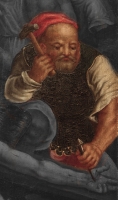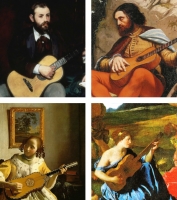01 Aug 2015
Joanna Woodall on Cooking Artists in Dark Rooms
Many are the ways to demonstrate that a given picture represents the artist in his or her mind: resemblance, pose, apparent errors, "nonsensical" shading, tools expressed in metaphor, etc. We have shown you at least thirty different methods, mos
05 Dec 2014 | 2 Comments
As in Painting, so is Poetry
The image above, a detail of a painting by Balthus called The Painter and His Model, goes particularly well with the poem below by James Merrill. Balthus, his head wrapped in a cloth to keep paint off his hair, seemingly pulls the curtain aside
20 Aug 2014
The Craftsman’s Christ
This is a scene by an unknown 16th-century artist, probably Flemish, at a time when artisanal effort was admired not just for the perfection of the end-product but for the artisan’s closely-guarded knowledge of materials. Wood, stone, minerals,
26 May 2014 | 1 Comments
Magic from Matisse and Michelangelo
What does Matisse’s figure from Dance II (1910) have to do with Michelangelo’s St Peter from the Last Judgment (1534-41). More than you might think. Bear with me. Both are nude against a blue sky, facing us and facing left; both look a littl
08 May 2014
Dutch Royals Are Artists
I received a message from the Rijksmuseum that their superlative site, the Rijkstudio, now has a collection of Dutch royal portraits. Anyone who has seen on EPPH how portraits of British, Italian and French royalty resemble the artist might wonder
17 Apr 2014
Manet’s Spanish Singer Raises a Leg
Inspiration can come from anywhere so it's a good idea to look at the art of all periods. Artists do so, no matter which century they live in. A few days ago I solved one of my long-standing problems with a picture by the19th-century artist Edou
14 Apr 2014
Joseph Cornell gives birth to a box…
Birthing, physical birth, is one of poetry and art’s most powerful metaphors used for many centuries, perhaps ever since art first appeared. It plays on the relationship between sexual conception and mental conception while often conveying that
13 Apr 2014
The Artist is Always Present
Very few novels use the first person pronoun, most using an impersonal narrator to describe the scene. The author David Henry Thoreau noted that, with the ‘I’ omitted, the reader forgets that it really remains there because the novelist is c
09 Feb 2014
Artists and the Thumb-hole of a Guitar
I read once that Cézanne prepared his palette with as many as 18 pigments and lined them up in a series like musical scales.1 It’s an apt analogy because painters have long portrayed musicians as an allegory of their own poetic performance in
05 Jan 2014 | 2 Comments
How God became Woman
Art is so pregnant that it can take months for its hidden meaning to emerge in your thought. That’s why we try to enter the artist's mind, not just through social customs and the religious dogma of a period but also through art's own culture w
26 Nov 2013 | 2 Comments
Tips to Tell Art from Illustration
My definition of art, as I've said before, is not as wide as that used by the public and most scholars. I do not believe, for instance, that children create art nor the vast majority of adult painters. True artists paint themselves; they paint i
21 Sep 2013
Pens, Palettes and their Visual Metaphors
Thoth was an Egyptian god best known in art as having the head of an ibis (above left). He had many functions but was perhaps most celebrated as the scribe of the gods, the inventor of heiroglyphs and writing, and who, when people died, wrote do
17 Jul 2013 | 1 Comments
Michelangelo Rocks in The Battle of Cascina (1504)
This post explains additional obervations not included in the original article here on Michelangelo’s The Battle of Cascina, a 1504 cartoon for a never-completed mural in the civic heart of Florence. It is one of the most celebrated and influe
18 Feb 2013
1+1=1: The Divided Self in Manet’s Railway
What is the girl up to? Who are they? What's happening? Why do they wear the same color clothes? Why is the girl's hair so odd?
In my explanation two years ago of Edouard Manet’s The Railway (1873) I noted that the extended arm of the
01 Dec 2012
Pointing at the Edge
If you cruise the various interpretations on this site, you might have noticed a tendency to explain a figure with an arm or hand pointing to or touching the edge of the image as the artist himself painting a self-portrait. Michael Fried first n
17 Nov 2012
Mental images from Holbein, Ingres and Picasso
It is well-known that Picasso admired Ingres' portrait drawings like the one above on the left. Separately I have shown how Ingres, like other great masters, changed the facial features of his sitters to fuse them with his own. Not all portraits
07 Oct 2012 | 7 Comments
Michelangelo’s Skull
In the three-part article on Michelangelo's Art Through Michelangelo's Eyes (2005) I argue that Michelangelo's Last Judgment is a scene inside the artist's mind with many of the figures formed into a giant view of his poetic hero, Dante Alighier
21 Sep 2012
Impressionism and Fashion
Impressionism and Fashion is the title of a new exhibition opening at Paris' Musée d’Orsay this coming Monday. The key image on the catalogue’s cover and the Museum’s website is Manet’s Young Lady of 1866
18 Jul 2012
Errors! Errors! Errors!
This is a piece of advice that I need to keep giving in case some newbies on the site have missed it. Even I sometimes forget it but Its importance cannot be overstated and is regularly overlooked in conventional art history. Look for the passag
11 Jul 2012
Bless you! It’s Art
Keep your eye open for a handkerchief or white cloth. They can be highly significant. My own experience suggests that those who are not painters themselves are relatively unaware that a cloth is almost as important to the craft of painting as a
01 Apr 2012
Eureka! My Last Judgement on Michelangelo’s
Eureka!
For years I have struggled with the meaning of Michelangelo’s Last Judgment. The essay “Michelangelo’s Art Through Michelangelo’s Eyes” explains my overall understanding of the Sistine ceiling and the altar wall on whi
The EPPH Blog features issues and commentary.



















